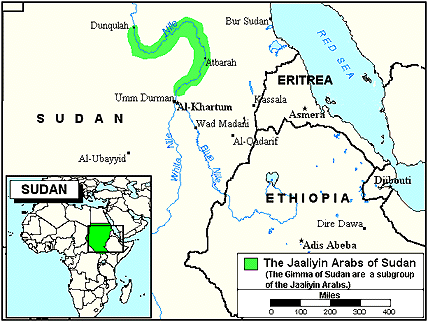|
|
Prayer Profile
The Gimma of Sudan
![[IMAGE]](../images3/0525.jpg) One of the most striking characteristics of Sudan is the diversity of its people. The Sudanese are divided into 19 major ethnic groups and nearly 600 sub-groups. In addition, they speak more than 100 different languages and dialects.
One of the most striking characteristics of Sudan is the diversity of its people. The Sudanese are divided into 19 major ethnic groups and nearly 600 sub-groups. In addition, they speak more than 100 different languages and dialects.
The 96,300 Gimma are a sub-group of the Jaaliyin Arab (also known as the Gaalin). They live between southern Nubia and the Gezira region of Sudan. Other sub-groups of the Jaaliyin include the Dangala, Hassaniya, Kawahla, and the Husaynat. These Jaaliyin Arab claim to be direct descendants of the prophet Mohammed, but some ethnologists consider them to be an "Arabized" Nubian group.
Sudan's leaders proudly boast that they are the leaders of the Islamic revolution in Africa. The Arab minority has used this as a tool to strengthen their personal control of the economy and their political power. The tragic cost of this has been more than a million people killed, an economy devastated, and a country divided.
What are their lives like?
Those Sudanese who consider themselves Arab are generally racially mixed, and many of them are indistinguishable from blacks living in southern Sudan. Despite a common language and religion, the "Arabs" are not a unified group. They differ greatly in occupation and way of life and consist of city dwellers, village farmers, and nomadic herdsmen. The Arab have historically been divided into tribes based on presumed descent from a common ancestor. Each tribe or cluster of tribes is assigned to a larger tribal grouping. Today, this system has largely disappeared in the cities and settled villages and exists only among the nomads of the plains.
Little is known about the specific lifestyle and culture of the Gimma; thus, some assumptions have been made in this profile. About two-thirds of Sudan's population is engaged in subsistence farming or grazing, though only about five percent of the land is suitable for farming. Many farmers live in the southern part of the country or in the grasslands of central and western Sudan. Sorghum and millet are the main crops grown there, but wheat, corn and barley are also raised. In Sudan as a whole, the main crops are cotton, peanuts, sesame, gum arabic, durra (a type of sorghum), sugarcane, coffee, and dates.
Since water is scarce, rural settlements in Sudan are usually clustered near sources of water. In the north, villages are often strung out along the rivers. The types of houses built vary from north to south. In the north, houses are made of sun-dried bricks and have flat-topped roofs. In the central and southern portions of the country, there are round huts with thatched, cone-shaped roofs made of grass, millet stalks, and wooden poles. In central Sudan, walls made of millet stalks often surround compounds.
Though towns are few and widely scattered, about 20% of Sudan's population can be considered urban. Southern Sudan was the least urbanized region in 1956, but has since seen much urban growth.
What are their beliefs?
A major rift exists between the northern and southern parts of Sudan. The north is dominated by Muslims, most of whom speak Arabic and identify themselves as Arabs. The people of the south are primarily black Africans, who, for the most part, follow traditional African religions. Also, some Christians can be found in the south.
The Gimma are 99.9% Sunni Muslim. Sunni Islam in Sudan, as in much of the rest of Africa, has been characterized by the formation of tariqas, or Muslim religious brotherhoods. The oldest of these tariqas is the Qadiriyah, which was introduced to Sudan from the Middle East in the sixteenth century. Another major brotherhood is the Khatmiyah, or Mirghaniyah, which was founded in the early nineteenth century.
What are their needs?
The Gimma have few Christian resources available to them, and there are no missions agencies currently working with them. Intercession and pioneer missions efforts are both required to bring the Gimma to Christ.
Prayer Points
- Ask the Lord to open the doors of Sudan to the preaching of the Gospel.
- Pray that Christian radio broadcasts, evangelical literature, and the Jesus film will be made available to the Gimma.
- Pray that God will reveal Himself to the Gimma through dreams and visions.
- Ask the Lord to save key leaders among the Gimma who will proclaim the Gospel to their own people.
- Pray that God will strengthen, embolden, and protect the few Gimma believers.
- Take authority over the spiritual principalities and powers that are keeping the Gimma bound.
- Ask God to raise up prayer teams who will begin breaking up the soil through worship and intercession.
- Pray that strong local churches will be raised up among the Gimma.

Statistics
Latest estimates from the World Evangelization Research Center.
THE PEOPLE
- People name: Gimma
- Country: Sudan
- Their language: Sudani
- Population:
- Largest religion:
- Christian: <1%
- Church members: 19
- Scriptures in their own language: Portions
- Jesus Film in their own language: None
- Christian broadcasts in their own language: Available
- Mission agencies working among this people: 0
- Persons who have heard the Gospel: 18,300 (19%)
- Persons who have never heard the Gospel: 78,000(81%)
THEIR COUNTRY
- Country: Sudan
- Population:
- Major peoples in size order:
- Major religions:
- Number of denominations: 20
© Copyright 1997
Bethany World Prayer Center
This profile may be copied and distributed without obtaining permission
as long as it is not altered, bound, published
or used for profit purposes.
![[HOME BUTTON]](../graphics/home.jpg)
![[CALENDAR BUTTON]](../graphics/calico.jpg)
![[LIST BUTTON]](../graphics/listico.jpg)
[Home]
[Calendar]
[Country List]
|